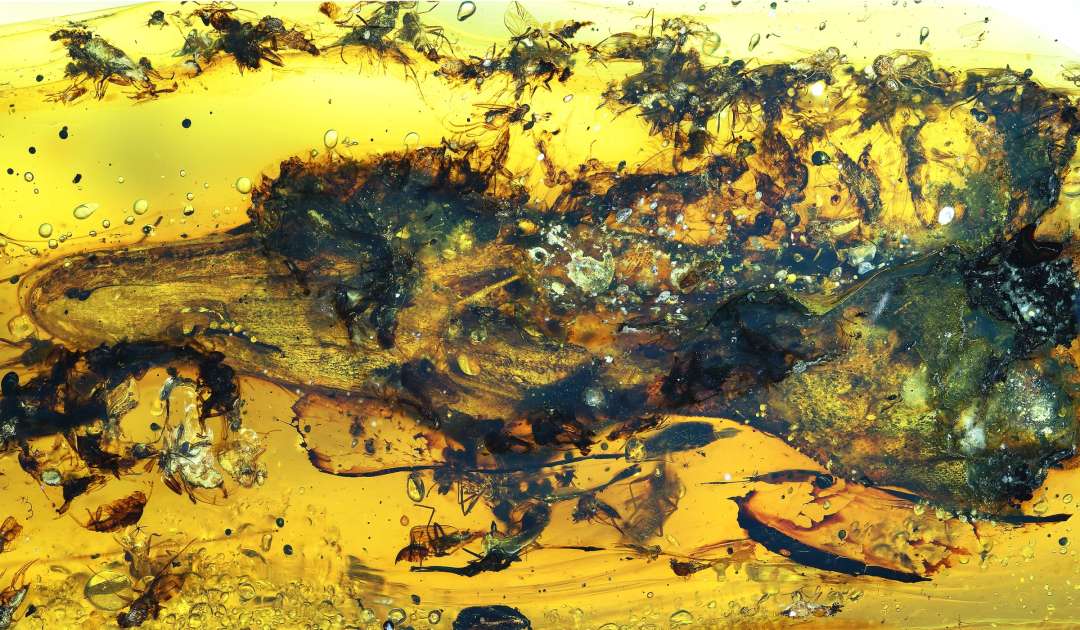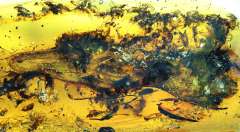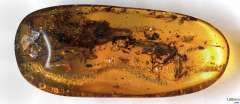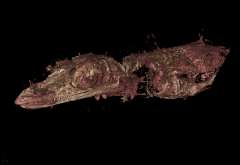In the Necrophagous Trap
Cretaceous amber preserves lizard carcass with necrophagous insects – ants are not among them
An international team of scientists led by Mónica Solórzano Kraemer of the Senckenberg Research Institute and Natural History Museum Frankfurt has studied a series of excellently preserved Cretaceous amber specimens containing lizard carcasses enclosed together with carrion- eating insects. The results of their study, now published in the journal “Nature Scientific Reports,” show that the reptiles, which were preserved in an early stage of decomposition, had attracted typical necrophagous flies – but no ants. These insects, known today as the “health police of the forest,”apparently did not yet play a role as scavengers 99 million years ago.
When a living creature dies in nature, a variety of different organisms are involved in decomposing the carcass. The study of the complex succession of scavenging insects and larvae that feed on a dead organism at various stages of its decomposition – so- called destruents – is a core area of forensic science. However, with few exceptions, cadavers, along with their destruents, are virtually absent from the fossil record. Knowledge about the evolution of necrophagous insects is correspondingly limited. Dr. Mónica Solórzano Kraemer, together with researchers from the CN-Instituto Geológico y Minero de España CSIC, Valencia, the Universities of Barcelona and Yangon, the Natural History Museum Los Angeles, and the Peretti Museum Foundation, has now studied some rare examples: lizards enclosed in amber along with necrophagous flies that were preserved in tree resin 99 million years ago. The inclusions have virtually “frozen” a specific moment in the process of decomposition and recycling and allow conclusions about the state of evolution and the role of early necrophagous insects during the Cretaceous period.
“We have studied three outstanding amber specimens from Myanmar, each of which contains a lizard enclosed in the same fossilized resin layer along with a variety of scavenging insects,” reports Solórzano Kraemer, and she continues, “Such inclusions are exceedingly rare – presumably, because the reptiles were often able to extricate themselves again from the sticky resin due to their body size. Inclusions with scavengers in the same resin layer are particularly uncommon. Often, creatures that appear to have been preserved together in amber are actually located in separate, adjacent layers – the spatial proximity suggests a biological relationship that may not really have existed at all.” Together with the lizard carcasses enclosed in a resin layer, the researchers found a large number of necrophagous flies from the families of scuttle flies (Phoridae) and dagger flies (Empidoidea)
Among the examined amber specimens, one piece stands out: just over five centimeters long, it contains a lizard of the now-extinct species Oculudentavis naga and more than 130 animal and plant inclusions in a total of 13 resin layers. “What is special is that the layer in which the lizard is enclosed reveals an ‘open window,’ asmall area at the neck where the carcass is insufficiently covered by resin,” says Solórzano Kraemer, and she continues, “This presumably allowed the odor of decay to spread, attracting various necrophagous and predatory flies in large numbers, which in turn stuck to the resin and were preserved. A ‘necrophagous trap’ – this is the term we propose in our study for this type of preservation trap.”
As shown by experiments, various fly families still act as typical destruents today, visiting lizard carcasses in an early stage of decomposition – but so do ants. In the ambers studied, however, ants are entirely absent. “Today, ants play a pivotal role in carrion removal in tropical forests – simply because of their sheer mass. The global biomass of all ants exceeds that of mammals or birds,” explains Solórzano Kraemer, and she adds, “Ants are generally rare in Cretaceous fossil deposits. The fact that they are completely absent from the ambers we studied suggests that tracking and decomposing carrion was not yet part of their feeding strategies at that time. Ants apparently did not develop these skills until later.”
Publication
Solórzano‐Kraemer, M.M., Peñalver, E., Herbert, M.C.M. et al. Necrophagy by insects in Oculudentavis and other lizard body fossils preserved in Cretaceous amber. Sci Rep 13, 2907 (2023). https://doi.org/10.1038/s41598-023-29612-x



